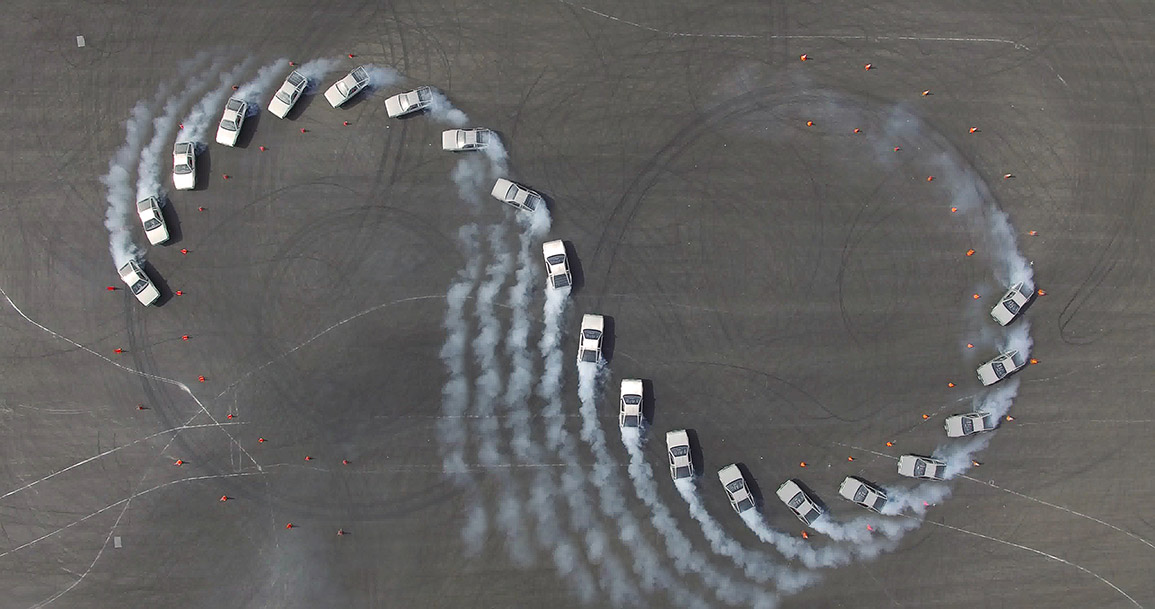Meet the All-Electric Autonomous 1981 DeLorean that Drifts!
Two Mechanical Engineering Grads from Stanford converted DeLorean and taught it to drift. For science, of course.
The setting is Thunderhill Raceway in Northern California. Jon Goh and Tushar Goel, the two genius brains of the operation, are what made this whole thing possible. The star, however, is the 1981 DeLorean appropriately named “MARTY” (coined after Michael J. Fox‘s character in Back to the Future, of course). Utilizing their recent Stanford doctorate mechanical engineering degrees, Goh and Goel took an iconic car from an iconic movie, gave it an equally iconic name, took out the crappy stock engine and made it electric, and then gave it a mind of its own. With a laptop and the resources at Stanford’s Dynamic Design Lab, Goh and Goel taught MARTY how to drift — but it wasn’t for fun (though we know watching it blow smoke most definitely involved that). It was for science.
As told by Bjorn Carey for Stanford’s new page, these two grads state that their mission with Drifty McFly (couldn’t help that one) wasn’t to travel back in time after getting up to 88 mph (or that one). It was actually made to test an autonomous car’s ability to follow a difficult course and driving conditions, to make autonomous cars safer overall. They just picked a DeLorean because, well, why not? After all, if a car can drift around a pedestrian instead of bowling through them for the sake of its driver, that’s the best alternative, right? According to those at Stanford who brought MARTY the DeLorean to life, that’s the case.
“We’re trying to develop automated vehicles that can handle emergency maneuvers or slippery surfaces like ice or snow,” said Chris Gerdes, a Stanford professor that pilots the world’s toughest handling autonomous cars with his students at the Dynamic Design Lab. “We’d like to develop automated vehicles that can use all of the friction between the tire and the road to get the car out of harm’s way. We want the car to be able to avoid any accident that’s avoidable within the laws of physics.”
Sounds simple enough. Program MARTY’s highly developed GPS system to follow the track that Goh, Goel and Gerdes set up, collect the data after a few runs, analyze, then perfect it. Then, push the car to its physical limit, and tell it to push through it — thus, the drift factor. Incredibly, once the car learns the track, it doesn’t hit a single cone during full beast mode — not even slightly. Their logic of, ‘an autonomous car that knows how to drift is safer for pedestrians’ comes from a pretty simple train of logic. If an autonomous car has the ability to stay stable in conditions that other cars would became unstable, it would make for a safer car.
“The results so far are rather outstanding,” mused Gerdes. “The stability control systems of modern cars limit the driver’s control to a very narrow range of the car’s potential. With MARTY we have been able to more broadly define the range of conditions in which we can safely operate, and we have the ability to stabilize the car in these unstable conditions.”
However, MARTY had to go through some other changes to be able to handle drifting. As aforementioned, the stock DeLorean motor was immediately thrown out. Taking its place are two Renovo electric motors, of which put 516 ft lbs or torque (or, 700 nm) to each of the rear wheels. The suspension set up was reportedly too squishy to handle the demands imposed by drifting, so MARTY was fitted with a custom set up capable of coping. Next up was replacing the steering with electronic steering, updating the brakes, and fitting the dash with various buttons and computers.
“Through drifting, we’re able to get to extreme examples of driving physics that we wouldn’t otherwise,” said Goh. “If we can conquer how to safely control the car in the most stable and the most unstable scenarios, it becomes easier to connect all the dots in between.”
With what these Stanford folk have accomplished with MARTY, the all-electric autonomous drift car, can only spell out greater things for the future for autonomous cars. All three of the incredibly talented and intelligent Stanford grads (and professor) have alluded to MARTY not being the end of what they plan to do. They’ll all be back, with MARTY, to further test boundaries and bring safer cars to the public.
Photos: Jon Goh


